Double sonnet with two reading directions entitled Sonet 1587.
1587
One leaf (155 x 100 mm) mounted on the flyleaf of a small in-8 volume (175 x 120 mm), (6)ff., 955 pp., (8)ff. with (26)ff. between pp. 608 and 609, brown chagrin, gilt edges; pp. 523 to 536 bound after p. 552 (19th century binding).
This is a very rare example of double sonnet with two readings directions composed at the height of the struggle between the King of France and the Duke of Guise.
Plus ne faut endurer / Des Bourbons la maison
La Ligue des Lorrains / C'est l'appui de la France
Ils tiennent en leurs mains / De l'éstat la défense
Le fer pour nous tuer / C'est la Religion
Il faut donc abhorrer / Les princes de Bourbon
Les Castillans desseins / Dompteront l'insolence
De ces loups inhumains / Et la fière arrogance
Nous voulans dévorer / A leur ambition
Qui est plus proche aux Rois / Que la maison de Guise
Qu'un prince Navarrois ? / Ne pille plus l'Eglise
Contre l'usurpateur / Le ciel est irrité
La noblesse se pleint / D'un si cruel ravage
Voyant un coeur menteur / Qui d'un titre emprunté
Sous un pretexte saint / Commet ardente rage
Entitled Sonet 1587, at first glance this double sonnet seems to defend the future king Henri IV and the Bourbons against the League led by the Duc de Guise: Plus ne faut endurer / La Ligue des Lorrains [plus loin] Des Bourbons la maison / C'est l'appui de la France.
In fact, the poet supports the League, a meaning that becomes clear when the sonnets are read as a single poem in alexandrines: Plus ne faut endurer Des Bourbons la maison / La Ligue des Lorrains C'est l'appui de la France.
This anonymous double sonnet is a brilliant example of militant poetry in France during the Wars of Religion. Never printed, the poem was rediscovered and published by Sylvia L. England, who discovered a slightly different version in the Commonplace book manuscript of Edward Hoby (1560-1617) in the British Museum (1). It is also cited as a remarkable example by Mark Greengrass in France in the Age of Henri IV: The Struggle for Stability (2).
France had already been torn apart by more than twenty years of religious wars when, in 1584, Henri III recognized Henri de Navarre, head of the House of Bourbon, rival house of the Guise, as his legitimate heir. Henri de Guise led a rebellious movement known as the League. In this capacity, he signed the Treaty of Joinville with King Philip II of Spain, under which the latter gave financial support to the League. He was one of the promoters of the Edict of Nemours (July 7, 1585), by which Henri III revoked the Edict of Pacification and re-launched the war against the Protestants.
In the 19th century, this sonnet was pasted opposite the title of a collection by Toussaint du Bray in his 1627 edition.
This classic 17th-century collection of poems contains the finest verses by Malherbe, Racan, Monfuron, Maynard, Bois-Robert, l'Estoille, Lingendes, Touvant, Motin, Mareschal and other famous court wit. It is the first collection to show Malherbe's poetic preference for Ronsard. This edition contains 538 pieces, 318 of which are first editions. 8 unencrypted leaves of poems by Bois-Robert are sometimes mentioned, but do not appear in this copy.
(1) Sylvia L. England. Some unpublished French Political Poems of the Sixtheenth Century. The Modern Language Review. Vol. 32, No. 3 (Jul., 1937), pp. 400-407.
(2) Mark Greengrass. France in the Age of Henri IV: The Struggle for Stability. Londres and New York, Routledge, 2013. p. 46.
4 800€
En stock
Nous contacter








